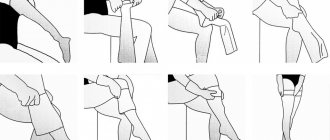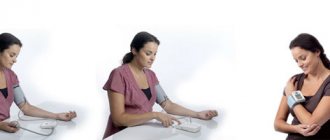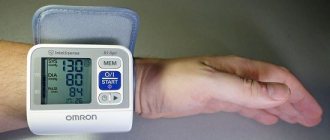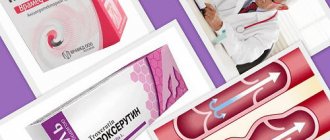Veins are half of the circulatory system.
It is also a source of concern for millions of people around the world.
Vein diseases are widespread. Scientists estimate that up to 15% of middle-aged men and 30% of middle-aged women suffer from varicose veins - dilation of the vessels of the venous system. Among the elderly, the proportion of patients with venous diseases is even higher.
Therefore, many people turn to doctors to treat swollen blood vessels. Sometimes with the help of surgery. In other cases - conservative therapy consisting of medications, exercises and special underwear.
We'll talk about stockings for varicose veins later. In the meantime, let’s evaluate the danger of the disease and its possible complications.
Varicose veins can affect any part of the venous system, but its favorite target is the vessels of the legs.
The vulnerability of veins is explained simply.
When blood flows through the arteries to the organs, it mainly moves downwards. That is, the force of attraction helps blood flow and therefore blood does not usually accumulate in the arteries. It flows through the arteries to the feet. The blood rises back through the veins. At this moment, problems begin - the force of gravity slows down the blood flow, and some of the blood constantly strives to flow down.
The situation is not dire. Yes, blood circulation in the veins is difficult, but the body has protective mechanisms against such trouble.
Venous valves grow inside the vessels, which close the passage of flowing blood and return it to the bloodstream. Muscles also help blood move. They contract and put pressure on the veins, and as a result, blood circulation improves.
In diseased vessels, blood flow is impaired. This happens for various reasons:
- Long immobility
- Obesity
- Elderly age
- Pregnancy
- Hormonal imbalance
In varicose veins, the valves are usually weakened or damaged. Therefore, blood accumulates in certain areas of the vessels, puts pressure on the venous walls and causes expansion.
The symptoms are not the most severe at first:
- Feeling of heaviness in the legs
- Blue or purple blood vessels appear on the skin
- Convulsions
- Edema
- Change in skin color
- Itching and burning in the veins
Such signs of illness often go unnoticed, and sometimes people simply get used to them. Thus, they allow varicose veins to develop.
Yes, it may take more than one year for more severe symptoms to appear. But without treatment, complications are inevitable, and they are not at all as harmless as the first manifestations of varicose veins.
Consequences of advanced varicose veins:
- Trophic ulcers
Non-healing wounds near diseased vessels. The tissues do not receive the necessary nutrients and gradually die. A symptom of an ulcer is the area of skin turning white. To stop the development of complications, you need to consult a doctor as soon as possible.
- Bleeding
Enlarged superficial veins sometimes burst. Bleeding from such vessels is not very severe, but medical attention is still necessary.
- Blood clots
Dilated vessels are a comfortable environment for blood clots, which doctors call thrombi. These formations interfere with blood circulation. They also sometimes come off and can get into the lungs with blood. This phenomenon is called pulmonary embolism and it often leads to breathing problems and even death.
The further the disease progresses, the higher the risk of complications. Another problem is that developed varicose veins usually cannot be eliminated with conservative treatment and surgery is required.
It is much easier to deal with it at an early stage. Complex treatment using stockings against varicose veins shows excellent results. This underwear is also useful for preventing illness.
Functions of compression garments
This type of clothing is prescribed for preventive and therapeutic purposes. Each of the venous diseases is associated with significant expansion of the veins.
The principle of operation of a compression product is based on the difference in pressure created across the limbs. The shin accounts for an average of 70% of the pressure, and the thigh about 30%. The veins contract, blood is pushed out, and blood flow stabilizes.
Externally created compression using properly selected knitwear gently and gradually compresses the venous walls. This allows:
- improve the quality of blood circulation in the body’s vascular system;
- normalize blood flow, and with it blood pressure;
- reduce blood viscosity;
- gradually reduce the diameter of blood vessels;
- improve tissue nutrition in the body;
- reduce the risk of blood clots;
- reduce external manifestations in the form of venous networks, “stars”;
- eliminate swelling and pain.
That is, compression knitwear allows the veins not to expand due to their own elasticity and the pressure created on the body.
How does anti-varicose underwear work?
Compression hosiery has a compressive effect on the veins of the lower extremities and brings the leaflets of poorly functioning valves closer together, thereby protecting the veins from stretching and accelerating the outflow of blood. The healing properties are based on precisely calculated and dosed pressure on the venous wall; the compression is graduated - maximum at the ankle (100%), smoothly distributed along the leg, decreasing towards the thigh (up to 40%).
For production, special fibers and materials are used to ensure comfort and safety of use.
In what cases are compression garments necessary?
These products are prescribed by specialists in cases of identified problems with the condition of the veins. Depending on the complexity of the situation, a specific type and class of compression equipment is assigned.
- Venous diseases: thrombophlebitis, varicose veins, thrombosis, lymphedema. The stages of these ailments require wearing elastic underwear with a compression effect to minimize the risk of developing vein thrombosis and improve the patient’s overall well-being.
- Use in the postoperative period allows for faster recovery. Despite bed rest, the patient will receive active blood circulation in the vessels due to external pressure from the elasticity of the underwear.
- During pregnancy, compression hosiery normalizes pressure in the lower extremities, improving blood flow. Heaviness in the legs, swelling disappears and the blue veins disappear almost completely.
- During the postpartum period, compression keeps the abdominal muscles toned, prevents prolapse of the internal organs and allows the mother to quickly return to physical shape.
- During sports training, the level of body fatigue is reduced, and pain syndrome is prevented during unusual or heavy loads.
- To maintain optimal well-being during long flights or during sedentary work, you should use stockings or tights for preventive purposes.
- Compression is also used in the field of dietetics as an additional tool for losing weight and removing excess fluid. Stockings and tights stimulate the reduction of fat deposits, smooth out the skin texture through micromassage and toning of the upper layers of the skin.
Are there any contraindications?
Compression hosiery is not a panacea for all vascular diseases. Therefore, when selecting products, it is important to provide the specialist with comprehensive information about your concomitant diseases.
Wearing compression products is prohibited in the presence of chronic arterial diseases, which are accompanied by a narrowing of the lumen of blood vessels. These are atherosclerosis, aortoarteritis, Raynaud's syndrome, polyneuropathy. Also, use for diabetic foot, trophic ulcers, and osteoarthritis is not allowed.
Relative factors for a wear ban are:
- tissue trophic disorders and dermatological diseases of a microbial nature;
- open wounds, bedsores, eczema;
- increased skin sensitivity;
- diabetes;
- deterioration of blood circulation due to heart or pulmonary failure.
Brief information about compression stockings for varicose veins
Anti-varicose stockings are made of special elastic knitwear that tightly grips the leg and creates the correct distribution of pressure in the venous vessels.
Mechanisms of action and effect:
- prevents stretching of the vascular wall - prevents reflux and venous stagnation;
- improves microcirculation, which is the prevention of trophic disorders of adjacent tissues;
- helps accelerate blood circulation, resulting in a reduced risk of thrombosis and thromboembolic complications.
Types of compression garments
Before wearing compression hosiery , you need to navigate the current range of models.
Most manufacturers make products from microfiber, nylon, lycra or cotton threads. The machines allow you to create a circular seamless weave that provides comfort while wearing. The elastic component is located inside the product, in a braid of fibers.
- Tights - tightly fit the legs, fit at waist level. Due to the soft belts and high elasticity of the material, they do not slip during wear. Help prevent the development of hemorrhoids. Externally, the product is no different from ordinary nylon tights.
- Stockings are a more practical option for use, requiring some skill and practice when putting them on. The stocking is very tight and dense; it requires some effort to pull it evenly over the limb. Cuffs can be universal for men and women, or with lace inserts.
- Knee socks are compact and comfortable, not visible from under clothes. Can be shortened or standard height. The elastic band is located below the knee. Unisex style product. The reinforced heel reduces pressure on the feet during active activities. The toe can be open or closed. Some brands have Velcro or zipper options for ease of putting on.
- Socks are often used by men at the initial stage of development of vein diseases. They look laconic, fit comfortably on the shin due to the thick elastic band and are made in various shades.
Permits
Compression products must have all the necessary certificates and permits in accordance with Russian legislation. First of all, this is a registration certificate from the Ministry of Health and a quality certificate. For compression tights from European manufacturers, be sure to check the availability of the European standard for medical compression products RAL-GZ 387. The standards of the standard determine the composition and safety of the material, compression properties, strength of knitwear and marking of compression stockings in millimeters of mercury indicating the compression class (1– 4). This is exactly what the marking of European quality certificates on the packaging of Sigvaris products looks like.
7 recommendations for choosing
Want to know how to wear compression stockings ? We advise you to first decide on the correct selection of products. This is influenced by a number of factors.
- Decide on the purpose of use: prevention, treatment or in the postoperative period.
- Visit a doctor to select the desired height of the product: tights, stockings, knee socks, socks.
- Buy compression boots strictly according to the required compression class.
- Choose the size based on the table indicated on the manufacturer's packaging. Before visiting the store in the morning, take measurements of the half-girth of the limbs: in the lower leg area, under the knee, in the middle of the thigh, under the buttock.
- When choosing a brand, pay attention to brands with a reputation as a reliable manufacturer who has been in this field for a long time.
- Take a closer look at the quality of tailoring: there should be no pronounced seams or joints, the material should look uniform in texture and color, and have excellent stretch.
- The final cost of the product depends on the quality of the materials used, innovative production techniques and international certification.
How to choose the right size?
With the same weight, build and height, the proportions and volumes of all people are different. And how effectively the underwear will work on your legs is directly dependent on how thick your legs are and how much the anti-varicose products will stretch on your legs. Each manufacturer produces its own size chart, but despite this, there are generally accepted patterns and standards. In order to choose the most correct size, which is guaranteed to provide a therapeutic effect, it is important to take the correct measurements:
- Find the round protruding bone on the ankle - the “junction” of the foot and lower leg. Measure the thinnest part of the shin. It is in this area that 100% compression is created.
- Mid-calf. Central point of the calf muscle. Mentally calculate the middle of the shin (along the “calf”) and take a measurement. At this point the compression will be at around 70%. When purchasing a golf course, this mark is moved under the knee.
- The next measurement point will be the mid-thigh circumference. The pressure at this point will be 40%.
- To select the size of stockings and tights, it is important to measure the length of the leg, which is measured from heel to groin, and when buying golf, from heel to knee.
- When purchasing tights, it is important to measure your waist and hips.
After all the measurements, compare the results with the table and choose the right size.
Anti-varicose underwear belongs to the class of goods that cannot be exchanged or returned, so choose these products as responsibly as possible so that money is not thrown away. Consult with specialists.
Jersey compression: 4 degrees for your health
Before putting on and wearing compression hosiery , it is important to determine the degree of compression pressure. It varies according to the severity of the disease and numerous individual factors.
Compression for prevention
Provides pressure within the range of 14-19 mmHg. Used for excess weight, cellulite manifestations, long flights and trips.
- relieves swelling in the calf muscles;
- relieves pain;
- Gives the skin a uniform, pleasant shade and texture.
1 class
It is actively used if there is a predisposition to varicose veins and the first obvious signs of varicose veins. Provides uniform pressure in the range of 19-23 mmHg.
Indications for wearing:
- visually noticeable bulge of the wreath;
- feeling of bursting heaviness in the evening;
- prolonged standing or sitting position, which is accompanied by pain;
- burning sensation in the calves.
Regular wearing of compression garments allows you to immediately eliminate the main symptoms and consolidate the effect.
2nd grade
It is used for obvious manifestations of varicose veins with a progressive perspective. Provides pressure of 24-33 mmHg. Used for bulging and obvious veins over 5 cm in length, the presence of pronounced nodes, cramps and swelling of the lower extremities. Also used after surgery.
3rd grade
Thrombosed veins with great depth and insufficiency of venous blood flow require wearing reinforced knitwear with a pressure of 35-47 mmHg. Relieves postthrombotic syndrome, large-scale swelling and trophic changes.
4th grade
The products exert strong pressure of more than 50 mmHg. and requires special equipment to put it on. Use is strictly under medical supervision. Used for lymphedema.
recommended products
Anti-varicose tights, compression class 1, 18-22 mm Hg.
Anti-varicose tights, compression class 2, 23-32 mm Hg.
Anti-varicose stockings, compression class 1, 18-22 mm Hg.
Anti-varicose stockings, compression class 2, 30 mm Hg.
Anti-varicose socks, compression class 1, 18-22 mm Hg
Anti-varicose socks, compression class 2, 30 mm Hg
Anti-embolic stockings (compression class 2), 25 mm Hg.
Device for putting on compression stockings
Men's anti-varicose knee socks, compression class 1 (18-22 mm Hg)
Men's anti-varicose knee socks with open toe, compression class 2 (23-32 mm Hg)
Men's compression stockings 1 class. 4214 ORTO
Buy compression tights →
See all
- 20% discount
- Leader
Compression tights medi Elegance class 2, small 292
In stock
9,000 rub. from 7,200 rub.
Buy
Code: 007709
medi, Germany
- Leader
Men's tights medi Plus II class, open toe 215M
In stock
8,000 rub.
Buy
Code: 007824
medi, Germany
- Leader
Compression tights Luomma Idealista class 2 dense ID-100 Normal
In stock
RUB 5,120
Buy
Code: 007718
LUOMMA IDEALISTA, Russia
- 20% discount
Compression tights medi Elegance 2 class 291
In stock
9,000 rub. from 7,200 rub.
Buy
Code: 007708
medi, Germany
- 20% discount
Compression tights Luomma Idealista 1st class transparent ID-100T Normal
In stock
RUB 5,110 from 4,088 rub.
Buy
Code: 009564
LUOMMA IDEALISTA, Russia
- 20% discount
Compression tights Luomma Idealista class 2 dense ID-100 Long
In stock
RUB 5,120 from RUR 4,096
Buy
Code: 007717
LUOMMA IDEALISTA, Russia
- 20% discount
Compression tights Luomma Idealista 1 class thick ID-100 Long
In stock
RUR 4,620 from RUR 3,696
Buy
Code: 007715
LUOMMA IDEALISTA, Russia
- 20% discount
Compression tights Luomma Idealista 1 class thick ID-100 Normal
In stock
RUR 4,620 from RUR 3,696
Buy
Code: 007716
LUOMMA IDEALISTA, Russia
- 20% discount
Compression tights medi Elegance 1 class 191M
In stock
9,000 rub. from 7,200 rub.
Buy
Code: 007706
medi, Germany
- 20% discount
Compression tights medi Elegance class 1, small 192M
In stock
9,000 rub. from 7,200 rub.
Buy
Code: 007707
medi, Germany
In stock
RUB 2,750
Buy
Code: 007776
ORTO, Spain
In stock
RUR 2,585
Buy
Code: 007770
ORTO, Spain
In stock
RUR 3,025
Buy
Code: 007773
ORTO, Spain
In stock
RUB 8,700
Buy
Code: 007694
medi, Germany
In stock
RUB 8,700
Buy
Code: 007695
medi, Germany
In stock
RUB 5,350
Buy
Code: 007702
medi, Germany
- 20% discount
Compression tights medi Comfort class 2, small CC217
In stock
RUB 8,700 from 6,960 rub.
Buy
Code: 007697
medi, Germany
In stock
RUB 5,350
Buy
Code: 007704
medi, Germany
In stock
RUB 8,700
Buy
Code: 007696
medi, Germany
Wearing knitwear correctly
How to put on compression hosiery quickly and with maximum comfort? To do this, follow the general rules:
- remove all accessories, as well as watches, from your fingers;
- cut your nails short and file them with a nail file;
- feet and legs should also be put in order: get rid of calluses, corns, and other roughness;
- the process should go slowly and carefully, with uniform distribution along the leg;
- Wear elastic underwear in the morning, before your feet are swollen. Or sit with your limbs elevated for 10 minutes to reduce swelling;
- your body, hand skin and products must be completely dry;
- If the degree of compression is high or you lack donning skills, then use additional devices.
How to put on stockings, tights, stockings or socks?
All therapeutic and prophylactic products in this range are put on in a similar way without additional tools.
- Remove from packaging and carefully straighten.
- Place your hands, clenched into fists, into the stocking and grab the heel area.
- Turn inside out, without letting go of the toe part, check for wrinkles.
- Insert your foot into the “pocket” that has formed. The heels of the jersey and the wearer should match without twisting.
- Carefully grasp the fabric a couple of centimeters from the ankle and pull upward.
- Grabbing 5 cm at a time, move higher up the leg, tightening the compression garment.
- Smooth the surface so that there are no wrinkles anywhere.
If your tights have an open toe, you should use the special silk socks that come with the kit.
In the case of low socks and knee socks, you can cope without additional devices.
Custom sizes
What is important to know if your measurements do not fall within the standards of compression garment manufacturers:
- When choosing a product, you should give preference to knee socks in the case of non-standard ones, because the main thing is to create compression in the lower leg, where the manifestations of varicose veins begin and develop most clearly and actively. Or give preference to products with an open nose so that the medical product fits correctly.
- If your sizes are at the junction of two sizes, give preference to smaller sizes so as not to lose the compression effect.
- It is important to take all measurements in the morning, immediately after waking up. There is no swelling at this time.
Congratulations, you have made your choice! In order for the product to serve you effectively for a long time, you must follow these simple rules:
Special devices to make donning easier
Do you want to know how to make wearing and dressing compression hosiery ? Use one of the popular devices.
Spray
Cares for the skin, moisturizes it and relieves pain during the first stages of use.
- Shake the bottle so that the emulsion is homogeneous.
- Turn the compression stocking inside out.
- Spray the liquid at a distance of 25 cm.
- Repeat the procedure before each dressing.
Gloves
Choose medical gloves strictly according to the size of your palm. They should have a slightly rough surface. Gently lift the jersey with your fingers and begin to gradually distribute it along the entire length of the leg. Due to the increased grip between gloves and compression garments, the latter will slide much easier.
Butler
The device is used by patients who have difficulty bending over or have difficulty reaching their feet. There are specimens with standard and extended handles, collapsible and stationary for bedridden patients.
The device has a design of several arcs with durable bases. Made of metal.
How to wear compression hosiery using Butler?
- The product is lowered with its toe down between two arches.
- The elastic band is carefully pulled over the arches and the stocking is lowered to the very base.
- Pull the stocking until the heel area is at the top of the device.
- Gradually place the stretched sock on your foot, moving the butler higher and higher on your leg.
- Carefully remove the device, leaving the underwear on the limb.
- Use gloved hands to smooth out possible wrinkles.
What material are miracle stockings made of?
The composition of compression knitwear includes cotton and nylon fibers, microfiber and lycra, so this material visually looks exactly the same as regular knitwear. The peculiarity of compression knitwear is that the product made from it has no seams. The material is hypoallergenic, pleasant to the touch and has excellent air permeability. The compression qualities of knitwear are imparted using the latest technologies. Compliance with simple rules for caring for the product guarantees the preservation of its medicinal properties for six months.
How long can you wear?
The duration of wear is determined strictly by the doctor who prescribed the use of compression hosiery.
In the initial stages of venous diseases, stockings are used for 3-4 months. If the situation is serious, lifelong wear may be needed. In the postoperative period, constant wearing is also ensured for 7-14 days.
The daily duration of wearing should not be less than 5-7 hours.
Most often, compression products are removed at night on the recommendation of the treating specialist.
Prevention of varicose veins
Stockings by themselves cannot eliminate varicose veins. They can only alleviate the patient’s condition and prevent the development of severe consequences, so the prevention of varicose veins comes to the fore, which consists of giving up bad habits and normalizing weight if there is a problem of obesity. It is very important to avoid heavy physical activity. Static veins are also harmful to the health of veins, so people with sedentary work need to get up and stretch more often. Women need to stop wearing high-heeled shoes all the time, leaving them only for special occasions.
Still have questions about compression stockings?
Free consultation with AngioClinic specialists
Author
Salmina Daria Vladimirovna
Geneticist. Graduated from the Chelyabinsk State Medical Academy. She completed an internship at the Northwestern State Medical University named after I.I. Mechnikov.
How to remove compression stockings?
We figured out how to wear compression hosiery . It's time to familiarize yourself with the method of removing it.
- Remove jewelry from your fingers and put gloves on your hands.
- Sit or lie down.
- Raise your leg so that you can reach it comfortably. Grasp the top of the product and gently pull it up to the ankle, avoiding wrinkles.
- Remove the stocking from the rest of your foot by turning it completely inside out.
When removing knitwear, you can also use additional devices such as butlers.
Anti-varicose stockings for pregnant women
During pregnancy, taking care of yourself and your health for the expectant mother comes to the fore. The safest way to stop the progressive development of the disease is to use anti-varicose jersey.
In the third trimester, the maximum load falls on the ankle and lower leg. Anti-varicose stockings, both during childbirth and pregnancy, can provide maximum compression to these areas.
However, before buying anti-varicose stockings, you should carefully read the tips on choosing compression stockings.
How to care for the products?
Having figured out how to wear and put on compression hosiery , you also need to understand the intricacies of care. Monitoring the condition of compression products will allow them to last much longer.
- Cleaning is carried out as the knitwear becomes dirty. Delicate hand washing is allowed at a temperature not exceeding 30C. Use a slightly alkaline shampoo as a detergent.
- After removing dirt, rinse the stockings in warm water and wrap them in a towel and wring them out lightly.
- Dry in a room with cool air. Stockings should lie horizontally on a towel.
- Do not dry the product in direct sunlight or near heaters.
- If your stockings have silicone stripes, keep them away from water. To clean, wipe the silicone inserts with a cloth soaked in ethyl alcohol.
- Never pull too hard on the top edge when putting it on, as this may damage the weave!
It is most convenient to purchase two pairs of stockings, which will be changed as they get dirty. Average service life is 6-8 months.
And now the bonus promised at the beginning of the article! When placing an order, enter the promotional code “ movement ” and receive a nice discount on your first order!
Caring for compression stockings
The stockings do not look like a durable product. And indeed, usually their service life does not exceed 12 months, and in many cases the linen breaks and becomes unusable even earlier.
What to do?
First of all, stockings need to be washed. Including knitwear with antimicrobial protection. Remember - you wear elastic underwear all day and dead skin cells constantly accumulate on it. So wash it daily.
It's best to do it manually.
For washing, use baby soap or other delicate products that will not damage the knitwear. You cannot boil laundry.
After washing, squeeze the water out of the stockings very carefully. Do not stretch them, otherwise you will damage the fabric. You can remove moisture with a towel.
Dry knitwear on a flat surface only in cool or warm places, as extreme heat can destroy the material.
Even with proper care, stockings will sooner or later lose their elasticity. Sometimes after just a few months. Less often - after a year.
How to change knitwear in time?
The loss of elasticity is easy to notice in the morning when you put on stockings. Old compression garments stretch very easily. Hence the conclusion - it no longer grips the legs with the required strength and therefore it is necessary to buy a replacement.










